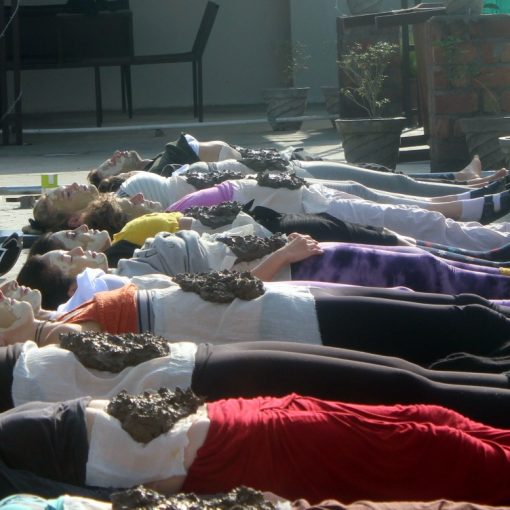Breath of Life: Learn How Pranayama Enhances Your Yoga Practice
In today’s fast-paced world, people seek tranquility and wellness more than ever. Yoga has long been a beacon for those pursuing mental peace and physical health. But as practitioners progress, they discover there’s more to yoga than just postures and movements. The practice of Pranayama – a disciplined approach to controlling one’s breath – can significantly enhance yoga practice, offering profound physical, mental, and spiritual benefits. At Alakhyog School in Rishikesh, India, we focus on integrating Pranayama with traditional yoga to deepen and elevate the yoga experience.

What is Pranayama?
The term Pranayama originates from Sanskrit, combining two words: “Prana,” meaning life force or breath, and “Yama,” meaning control. Pranayama involves a series of breathing techniques that aim to cleanse, energize, and balance the body’s energy. When paired with yoga, Pranayama brings harmony, enhances concentration, and prepares the mind for deeper meditative states.
Why Pranayama Matters in Yoga
1. Increased Lung Capacity and Health
Regular Pranayama practice improves lung function and oxygen flow throughout the body. Techniques like Kapalabhati (skull-shining breath) and Anulom Vilom (alternate nostril breathing) enhance lung efficiency, which in turn boosts stamina and energy during yoga postures.
2. Enhanced Mindfulness
Breath awareness during Pranayama increases mindfulness, allowing practitioners to maintain a calm, present mind. This focus not only aids meditation but also enhances the quality of each yoga session, as the practitioner is more attuned to their physical and emotional responses.
3. Stress Relief and Mental Clarity
In today’s stressful environment, Pranayama offers an accessible tool for reducing anxiety. Techniques like Brahmari (bee breath) and Shitali (cooling breath) calm the nervous system, offering relief from stress and promoting a clearer, more balanced state of mind.
Key Pranayama Techniques
1. Nadi Shodhana (Alternate Nostril Breathing)
- How to Practice: Begin by sitting comfortably. Close your right nostril with your thumb, inhale deeply through the left nostril, then close the left nostril and exhale through the right. Alternate for several breaths.
- Benefits: Balances the mind and promotes mental clarity, improving concentration and emotional stability.
2. Kapalabhati (Skull-Shining Breath)
- How to Practice: Inhale normally and exhale forcefully, contracting the abdomen. Repeat this cycle in quick succession, focusing on the exhalation.
- Benefits: Purifies the respiratory system, strengthens the diaphragm, and energizes the body.
3. Bhastrika (Bellows Breath)
- How to Practice: Take a deep inhale, followed by a vigorous exhale, resembling the blowing of bellows. Maintain a steady rhythm and repeat for a few minutes.
- Benefits: Increases vitality, oxygenates the blood, and enhances focus, making it an ideal energizing practice.
4 Bhramari (Bee Breath)
- How to Practice: Inhale deeply, and as you exhale, hum like a bee with lips gently closed. Repeat for several rounds.
- Benefits: Calms the nervous system, helps with insomnia, and improves concentration.
How Pranayama Complements Yoga Asanas
Yoga postures (asanas) focus on flexibility, strength, and alignment, while Pranayama centers on controlling breath. When combined, they form a holistic practice, allowing the practitioner to experience harmony between body and mind. Pranayama assists in maintaining balance, concentration, and calmness, making it easier to achieve and hold challenging postures.
At Alakhyog School, our experienced instructors blend Pranayama techniques with yoga postures to maximize these benefits, creating a comprehensive practice that aligns with your growth journey.
FAQs on Pranayama and Yoga
1. Can beginners practice Pranayama?
Yes, many Pranayama techniques are accessible to beginners. Start with basic techniques like Anulom Vilom and build up gradually.
2. How often should I practice Pranayama?
For best results, practice daily. Even 10-15 minutes daily can lead to noticeable improvements in mental clarity and physical energy.
3. What are the safety tips for Pranayama?
Always practice on an empty stomach and under a trained instructor’s guidance, especially for advanced techniques. Avoid forcing the breath as it may strain the respiratory system.
Conclusion
Integrating Pranayama into your yoga practice can be transformative. It enhances flexibility, improves mental clarity, reduces stress, and creates a profound mind-body connection. Exploring Pranayama at Alakhyog School can open doors to deeper self-awareness and wellness, whether you are a beginner or a seasoned yogi. Embrace the breath of life and experience how Pranayama can elevate your yoga journey.





